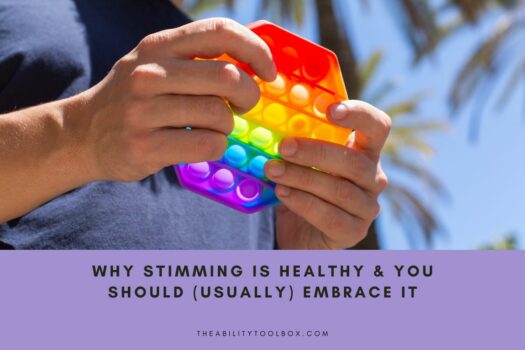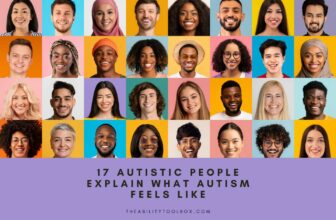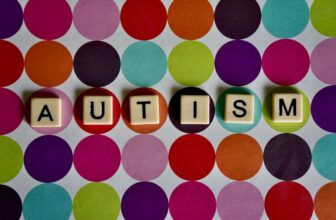Stimming is a key self-regulation tool for people on the autism spectrum or with ADHD. If you're neurodivergent or seeking to support your child, you're in the right place! In this guide, written by an autistic adult, you'll learn what stimming is and why it is usually a healthy outlet for sensory processing and emotional regulation. We'll also address what to do when stims are harmful and how to encourage helpful and healthy stimming.
What Is Stimming?
Stimming is short for self-stimulatory behavior or self-stimulation. Stimming refers to repetitive or rhythmic body movements, actions, or sounds. These repetitive behaviors are often seen in autistic and other neurodivergent children and adults. They are even part of the diagnostic criteria for autism spectrum disorder (or autism spectrum condition). In the medical literature, stimming with the body may be called “stereotyped movements” or “stereotypies.”
Many autistic and neurodivergent people engage in stims to cope with or express emotions (e.g., anxiety, fear, boredom, or excitement) or for self-regulation and sensory input. Everyone stims sometimes: tapping a foot, bouncing a leg, fiddling with a pen, and so on. But in autistic people, stimming is usually more frequent or recognizable.
While stimming is often most noticeable when it involves physical body movements, stims also come in different forms. For example, visual stimming might involve staring at flickering lights or a spinning fan. Some autistics stim by repeatedly listening to a song or smelling different objects over and over. There is less discussion of mental stimming but it could include, for instance, repetitively organizing thoughts.
Examples of Stims
Stims come in an endless number of types. Some of these repetitive actions are very noticeable but others are much more subtle, especially for high-masking autistics. However, stimming manifests differently for each individual. Not all autistics can easily hide or control their stims. And others don’t engage in stims more or less than neurotypicals.
Hand flapping and other hand stims
Stimming with the hands is quite common for neurodivergents. Hand flapping is a stim frequently associated with autism; it involves quickly moving the hands up and down near the body. Other examples are finger tapping or drumming, finger flicking, hand wringing or twisting, waving, clapping, and rubbing the hands together.
Body rocking and swaying
You might’ve caught people rocking their bodies rhythmically – back and forth or side to side – when they’re stressed or anxious. Like neurodivergent people, neurotypicals also do this to calm themselves and self-soothe.
While body rocking (or swaying) has long been associated with “classic autism,” it’s quite common for high-masking autistics too. They might body rock when sitting or standing.
Pacing
Like body rocking, pacing around is another full-body stim long linked with autism. As with all forms of stimming, some autistics might pace only when they’re alone or at home but others might pace in public.
Hair twirling
Possibly more common in autistic females, hair twirling or twisting is another stim. Other hair-related stims are repeatedly tucking the hair behind the ears, stroking the hair, chewing hair, or the more harmful stim of hair pulling.
Fidget toys and object manipulation
Stimming toys and tools have become more mainstream than ever before. They can help neurodivergent people to regulate themselves when they can’t stim in other ways. Fidget toys also help people cope with anxiety and ADHD, and they include pop-its (bubble toys), fidget spinners and cubes, and tangles, for example.
Likewise, stims can involve manipulating – or repetitively playing around with – different objects. I already mentioned fiddling with pens, but virtually any object (e.g., toys, books, clothes, coins) could be used.
Tactile stims
Specific objects (e.g., fabrics, toys, or surfaces) can also be sought out by neurodivergent people for their tactile qualities. They may be soft, squishy, textured, smooth, or otherwise rewarding to touch.
Vocal and auditory stims
Stims can take the form of repetitive vocalizations. These sounds might also serve the purpose of communication. Vocal stims might involve echolalia (repeating what others have said), humming, singing, whistling, repeating made-up words or noises, or throat clearing, among many others.
Auditory stimming can be vocal or might involve, for example, banging objects together to make repetitive sounds. Or listening to the same song on repeat. Some neurodivergent people use fidget toys as auditory stim tools as well.
Oral stims
Oral stims involve the mouth and aren’t necessarily noisy. They can include chewing gum or other objects, eating non-edible objects (pica is more common in autistic children), biting or sucking the lips or inner cheeks, nail-biting, or sucking on the thumbs or fingers.
How Stimming Helps Autistic and Other Neurodivergent People
A 2019 study found that autistic participants stimmed for four broad reasons: (1) overwhelming environment, (2) sensory overload, (3) noisy thoughts, and (4) uncontainable emotions. One participant explained that “the regulatory aspect of stimming worked through attending to a single point of focus over which one had control, to self-regulate by blocking or reducing excessive input.”
Another paper on stimming highlighted how it helped autistics to cope with sensory sensitivities and “allowed for positive and negative emotional expression, and cognitive distraction.”
Just like neurotypical people, autistics and other neurodivergent people stim in various ways as a coping mechanism. Mostly, it’s about regulation and expression. Stimming helps with self-regulation: emotional regulation, sensory regulation, and physical regulation.
In particular, stimming also helps neurodivergent people to:
- Regulate and express emotions
- Regulate their senses
- Deal with sensory overload
- Deal with physical pain or discomfort
- Create predictable/controllable input
- Communicate
- Improve their focus
- Distract themselves
- Deal with boredom
- Release pent-up energy
- Enjoy themselves (or for no reason in particular)
Emotional and Sensory Regulation
Mental health conditions are more common in neurodivergent people. For example, anxiety disorders affect autistics and ADHDers frequently. The studies cited above mention that stims help neurodivergent people distract themselves from unpleasant emotions and thoughts with an activity that they can control (and which is predictable).
Moreover, stimming expresses positive feelings (happiness, excitement) as well as “negative” feelings (anxiety, stress, overwhelm, fear, anger, etc.).
About regulating senses: Most autistic people will be hyposensitive or hypersensitive to one or more of their eight senses (yes, there are three others!). If they are overstimulated in one or more, they might stim to cope emotionally with overload or overwhelm.
Alternatively, to gain greater sensory input, they may use or seek out stims that activate a certain sense. I’ve already provided examples of how stimming can regulate certain senses (e.g., visual stims and auditory stims). However, there are three senses not as well known as the five most commonly cited – touch, taste, smell, hearing, and sight.
The vestibular system feeds us information about the ways our bodies are moving and balancing. So, regulating vestibular stims could be jumping on a trampoline, swinging or spinning, and body rocking.
Proprioception refers to a sense of our body in space. Helpful proprioceptive stims may include squeezing things; pulling, pushing, or carrying objects; giving big hugs; chewing; stretching; any activities involving deep pressure; and making “unusual movements” to receive more input about our body in space. (Or to “feel the body better.”)
Interoception is the eighth sense and helps us sense what’s happening within our bodies.
Sensory chairs are popular among neurodivergent kids and adults as they provide healthy vestibular and proprioceptive stims and can improve focus while studying and working.
Stimming and Stigma
A big reason some people mask their autism is due to societal judgments and stigma. While not all neurodivergent people mask, the ones who do have learned that their natural coping methods aren’t socially acceptable or expected. So, their stims can be subtle and difficult for the casual eye to pick up as stims (e.g., hair twirling, chewing gum, foot tapping).
Stimming in a visibly or recognizably “unusual” way can make one's neurodivergence and disability more obvious. This can put you at greater risk for rejection, harassment, bullying, and disability discrimination. Some autistics with higher support needs have commented that being visibly autistic meant they suffered more discrimination and that people saying, “But you don’t look autistic” was never part of their reality.
According to this article, 72% of autistic adults participating in a study “had been told not to stim at some point.” The research also found that stimming was frowned upon more as participants aged. (That’s the case for many autistic and neurodivergent traits.)
Within the autism advocacy community, applied behavioral analysis (ABA) is highly controversial and widely disliked. While it’s the most common “therapy” for autism, ABA also seeks to suppress and prevent natural autistic traits and replace them with neurotypical ones. This includes punishing healthy stimming, such as forcing autistic kids to have “quiet hands.”
ABA has resulted in long-term trauma. A 2018 study found that 46% of autistics exposed to applied behavioral analysis as children met the PTSD criteria.
When Stimming Hurts: Harmful and Self-Injurious Stims
Most stimming is healthy, but sometimes neurodivergent people can stim in ways that hurt themselves or others. Harmful stimming is often an expression of anxiety or anger, sensory overload, and/or physical pain, and people who engage in these behaviors need support and understanding, not judgment. For instance, stimming that hurts oneself could distract from other physical pain, such as by releasing endorphins.
Examples of Harmful Stimming
It’s important to distinguish between stims that are healthy but may appear “odd” to others (e.g., hand flapping), stims that are safe but disruptive in some settings (e.g., loud vocal stims, pacing), and genuinely harmful stims.
These harmful or injurious stims include:
- Head banging (against surfaces or objects)
- Biting
- Hair pulling
- Skin picking or scratching (including at wounds)
- Self-harm such as cutting or burning
- Eating non-edible objects
- In some cases, stims that lead to overeating or undereating
- Stims that can cause long-term damage to the senses
- Any other stim that causes physical harm to self or others
How to Stop Unhealthy Stimming
Whether for yourself, your child, or someone else, it’s important to address the root cause of harmful stims.
Address underlying physical health issues.
Physical pain, combined with difficulty expressing oneself, can lead to damaging stims. Non-speaking or minimally speaking autistics can use augmentative and alternative communication (AAC) systems to describe what they’re feeling.
Address sensory overload.
Reducing sensory overload by modifying or leaving an overwhelming, loud, unpredictable environment can stop harmful stims. Many neurodivergent people use noise-canceling headphones or fidget toys.
Teach/provide healthy alternative stims.
If, for example, there’s no escaping a stressful situation, hurtful stims can be replaced with healthy stims, even if they’re unusual to neurotypicals. These include body rocking, vocal stims, hand stims, etc. Specialized fidget toys for hair pulling and skin picking can be used to replace stims that hurt the body.
Provide safe outlets for anger and frustration.
Safe outlets for anger could involve non-harmful stims, fidget toys, physical exercise (punching a boxing bag, running), creative projects, or video games.
Tips for Accepting and Encouraging Healthy Stimming
So long as it’s not hurting anyone, stimming is a natural part of neurodivergence that should be encouraged in autistics and other neurodivergent people. You might already know which ones work best for you or your child.
If you’re a late-identified autistic in the process of discovering your authentic self, you might pay attention to how you behave when nobody’s around. What kinds of stims – repetitive behaviors – do you engage in when you’re free from anyone’s judgment?
For parents, here are some methods to encourage your child to stim in healthy and helpful ways:
- Try a variety of different fidget toys. Neurodivergent children may be sensitive to particular weights, textures, sensations, sounds, and so on. Experiment to see which fidget toys and tools they use the most in different situations.
- Help them develop self-awareness. For example, help your kid understand why they stim. Identify which senses are hyposensitive or hypersensitive (these can change).
- Find other neurodivergent children who stim. This could be in-person such as kids at school or online, like through YouTube videos. Connecting with other neurodivergent people is good for their self-esteem.
- Don’t shame them for healthy stimming. Teach them when certain stims are OK and when they’re disruptive or harmful and should be swapped for another stim.
- Normalize public stimming. Allow your kid to stim in public. This can prevent meltdowns or shutdowns from sensory or social overload.
Listen to Autistic Voices: Stimming Is Healthy & Necessary
Let’s hear from autistic content creators about their stims and what stimming means to them.
“What’s in my stim to go bag? I like to have three tactile stims which are soft and squidgy. Perfect for when I’ve got anxiety but I’m not frustrated. I like to have three motion stims which are movement-based and I can use by actively moving my hands … I like to have one big stim, this is almost always my putty but if I’m somewhere like public transport the motion cube is easier. I can’t fit both in one bag. Sometimes I use a fidget cube.”
JustKeepStimming, Instagram: @justkeepstimming_
“Stimming can be hugely positive and self regulating. Often autistic people can be told to stop stimming or it can be assumed that stimming equals stress. This is not always the case. Some autistic people may stim when happy, bored or even when they are confused and unsure of how they are feeling, stimming can be a good way to start the process of working out how one might be feeling.”
Lily, Instagram: @fidgetsandstims
“I think stimming is beautiful. It’s beautiful because it’s human. It’s beautiful because it helps to express myself. It’s beautiful because it helps to sooth[e] myself. It’s beautiful because it helps me when I’m happy and it helps me when I’m in pain. When I’m overstimulated or understimulated, it still helps.”
Lil Penguin Studios, Instagram: @autism_happy_place
Healthy stimming is vital for the well-being, mental health, and self-expression of neurodivergent individuals. Repetitive behaviors and actions might seem odd to others, but they help autistics and ADHDers to self-regulate their emotions, senses, and bodies. Along with expressing emotions, stimming distracts neurodivergent people from uncomfortable thoughts and sensory overload. Stims should be encouraged as long as they are not physically harmful or disruptive.
What are your experiences with stims and fidgeting as a neurodivergent person?
Share your story with our community in the comments below.
Monique Moate is a late-diagnosed autistic woman whose interest in autism spectrum disorder and disability stems from a lived-experience viewpoint. She enjoys the written word and thinking about how people use language.









Start the discussion at community.theabilitytoolbox.com